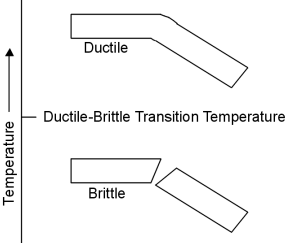Metallurgy is defined as the study of metals and minerals extracted from the earth’s crust with all its properties to be very well overlooked. Ductile Brittle Transition Temperature is also one of the most important and burning topics of metallurgy.
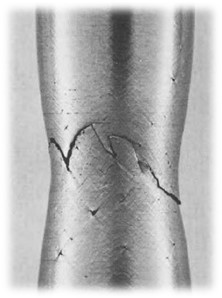
Metallurgical Engineering is one of the finest, cored and appreciated field of engineering that deals with all the industrial process.
Here we’ll be dealing with all the information related to Ductile Brittle Transition Temperature and its importance.
1. Why DBTT?
Before DBTT, let us discuss some of the points which outbid this process.
-
Fracture:
- It’s the separation of a solid body into 2 or more parts under the action of stress. It may be due to crack initiation, obliterate between two bodies etc.
- Fracture results in the creation of new surfaces.
-
Ductile:
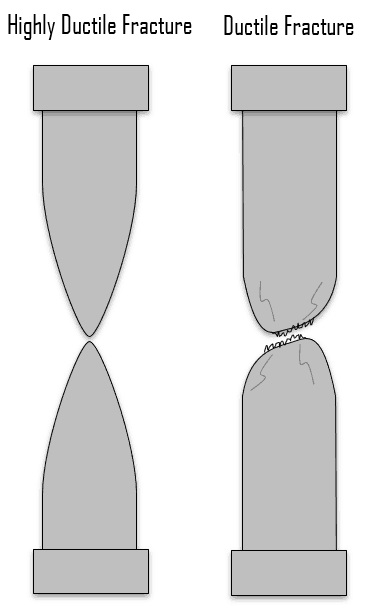
Ductile fracture tensile test.(Image From: nuclear-power.com)
- The appreciable plastic deformation that occurs prior to or during the propagation of crack is called its Ductility. It always preceded by localized deformation called necking.
- Under tensile load, cavities, cracks, the ductile fracture occurs. It undergoes in FCC at lower temperatures.
- The fracture of most ductile materials in polycrystalline form occurs with a cup and cone fracture.
-
Brittle:
- A rapid rate of crack propagation with no gross deformation or very little deformation is called its Brittleness.
- It’s normally occurring to the tensile stress. It has been observed in BCC & HCP as well.
- It occurs due to temperature & strain rate variance.
Ductility is especially important in metalworking, as materials that crack, break or shatter under stress cannot be manipulated using metal-forming processes such as hammering, rolling, drawing or extruding. Malleable materials can be formed cold using stamping or pressing, whereas brittle materials may be cast or thermoformed.
So now let’s discuss and come over what is DBTT & how does it vary in the metallurgical field?
2. Ductile Brittle Transition Temperature:
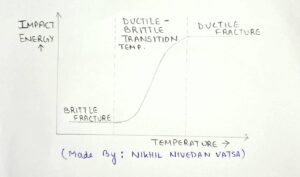
The minimum temperature at which the fracture energy passes below a critical temperature (standard Charpy Impact Test) is called Ductile Brittle Transition Temperature.
As temperature decreases, a ductile material behaves as a brittle allowing it to break rather than bend. It is the transition temperature below which a ductile plastic specimen becomes brittle.
The toughness of metal is affected by temperature. The metal exhibits brittle fracture up to certain temperature. After this temperature, up to a certain temperature, the metal exhibit mixed one fracture, i.e. ductile & brittle. Again after passing his range, the metal shows a ductile fracture.
Ductile materials have fracture strength lower than the ultimate tensile strength (UTS), whereas in brittle materials the fracture strength is equivalent to the UTS. If a ductile material reaches its ultimate tensile strength in a load-controlled situation, it will continue to deform, with no additional load application, until it ruptures. Rapid loading, low temperature, and triaxial stress constraint conditions may cause ductile materials to fail without prior deformation.
Ductile Brittle Transition Temperature is usually seen in BCC metals, such as low carbon steel, which becomes brittle at low temperatures. FCC metals, however, generally remains ductile in low temperatures. In metals, plastic deformation occurs due to dislocation motion. The stress required to move dislocation depends on crystal structures, bonding grain boundaries etc. If the stress is too high, the metal will fail by crack propagation and will cause a brittle fracture.
Also Read: Difference between Test Plan and Test Strategy
The Ductile Brittle Transition Temperature is characterized by a sudden and drastic change in energy variance due to impact loading. This transition is unknown in FCC metals but is very well known in BCC metals. As the temperature of the material decreases, the ability to absorb energy decreases; thus, nature becomes brittle. Increase in loading rates increases the absorbing energy with temperature, thus the ductility of material increases.
3. Impact Test- Izod Test & Charpy Test:
Impact testing is used to determine the brittleness of the material. Its principal is based on the theory that “a material breaks after absorbing a certain amount of energy”. If it breaks easily means it has a lesser quantity of energy absorbed thus is brittle in nature. And if it breaks after much time, it has absorbed a high amount of energy; then it is ductile.
-
Izod Test:
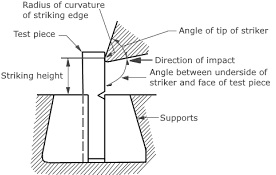
Izode test is the measure of energy as output upon hitting per unit thickness of material.(Image Source: Amity virtual Lab)
- This test machine consists of a heavy triangular frame. The machine is fixed with a pendulum weight swinging. First, the pendulum is lifted and clamped. It carries energy E with it during the swing.
- At the bottom, there is a vertically supported specimen in such a way that the notch surface should face the hammer. When the pendulum strikes the surface of the material, it carries potential energy (mgh), transfers the energy to the material.
- After a fracture, the pendulum rises on another side with energy (mgh1), less than (mgh). So the total energy E absorbed by the material is (mgh-mgh1).
- This energy indicates the energy required material to transform from ductile to brittle.
- The material specifications are: (75x10x10mm), 45° inclined.
-
Charpy Test:
- The Charpy specimen has a cross-section volume (55x10x10mm) and contains 45° V notch. here the pendulum is swinging at a speed of 5m/s. The specimen is fixed normally to the beam.
- The opposite face of the notch is fixed to get the strike of the hammer and the hammer strikes in the vertical axis.
- After breaking the specimen, the pendulum rebounds to a height which decreases as the fracture energy increases.
- The energy absorbed for Charpy test is CV. It is the relative energy and can’t be used directly for equation design.
- The impact test is meaningful if done for high range temperatures which tell the temperature at which the ductile to brittle transition takes place.
4. Factors determining Ductile Brittle Transition Temperature:
1. Temperature:
- At the higher temperatures, the yield strength is low, and the fracture is more ductile in nature.
- On the other hand, at lower temperatures, the yield strength is high, and the fracture is more brittle in nature.
- This temperature variance has to do with atom vibrations. This increased vibration allows the atoms to slip to new places under stress conditions when the temperature is a bit high. This is common in ductile fracture.
- While, when the temperature decreases the process is just opposite. The atom vibration decreases, and so thus, atom now does not want to slip. Thus, we have a brittle fracture.
- In conclusion, temperature determines the amount of brittleness and ductility variance in the material.
2. Dislocation Density:
- This is one of the factors that determined the amount of ductility or brittleness in a material.
- The higher is the dislocation density; the material is more brittle. This is due to because of theory “Plastic deformation comes from the movement of dislocations”.
- As the stress increases, the dislocation increases above the melting point of the material. It piles up the dislocation tightly and makes it difficult to move.
3. Grain Size:
- This is also one of the factors which determine the DBTT behavior of a material.
- The brittle fracture occurs to the extent until the grain sizes are smaller.
- When there are small grains in a material, the dislocations gets space to move easily from one place to other and hit the grain boundary.
- When the dislocation cannot move very fast, then there occurs plastic deformation, resulting in material to have a brittle fracture.
5. Metallurgical Factors affecting Ductile Brittle Transition Temperature:
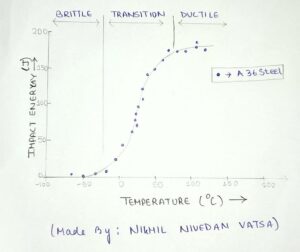
- When there is an increase of 0.1% C (carbon) content in steel, then 14°C temperature gradually increases. This shows that at a higher temperature, the materials get to transform from ductile to brittle nature.
- Higher the carbon content, higher the carbide in steel, thus higher is the brittleness behavior.
- When an increase of 0.1% Mn (manganese) is seen in steel, there is a 5°C decrease in temperature. This shows that at lower temperatures, the material turns its behavior from ductile to brittle.
- In order to maintain the transition temperature of the steel fixed, Mn & C are added with some fixed proportion, i.e. Mn:C :: 3:1. In order to maintain the stability and equality in the composition, the increase of 0.1% C with 14°C & 0.3% Mn with 15°C cancels out the change.
- The transition temperature of DBTT also decreases with decrease in grain size.
- As the striking velocity of the atoms increases, so the transition temperature does the same.
6. RMS Titanic- Metallurgical Failure:
We are very well known with “Titanic” and its failure but do we know what the exact and actual reason behind its failure was. This portion will tell every point explained in details about the failure of once considered “World’s Biggest Ship”-“Titanic”.
- Titanic was made by Low Carbon Steel having very less ductile-brittle transition temperature, i.e. -20°C, which resulted in the sinking of the ship. This L.C.S. used here was of BCC structure which exhibited the transition temperature from ductile to brittle.
- The wrought-iron rivets used in the construction of ship contained a large amount of incorporated slag which holds an exemplary explanation to the sinking of the ship.
- The Low Carbon Steel used in Titanic was of Ductile Brittle Transition Temperature nature – A 36 Steel. The sinking was due to the brittleness of the steel used in the construction of the hull.
- When an iceberg impacted on the hull of the ship, the bolts and rivets that were holding the plates gradually got fracture due to their brittle nature.
Now let’s answer some of the major questions that usually come in our mind:
How did Titanic sink so quickly?
- We all know that despite having advanced technologies and accommodations, the hull was fastened together with poorly casted wrought iron.
- The holes created in the ship hull allowed 6 compartments out of 16 to flood out very rapidly. This made the ship to tilt 45° and got misbalanced.
- The waters in 6 compartments rushed to its neighbouring compartments rapidly, resulting in the sinking of the ship in almost less than 3hrs.
What was the nature of the damage to the hull by the impact of the iceberg?
- When the Titanic hit the iceberg, the hull plates which were fasted by cheap wrought iron rivets opened up and allowed waters to flow inside the compartments.
- Low water temperatures and high impact load caused the Low Carbon Steel to break instead of bend and rivets were parted by.
Did the titanic break half at the surface or it sink intact?
- Due to the failure of rivets and plates, the impact of the iceberg caused the hull of the ship to break apart and split into 2 parts.
- The 1st part sank very quickly because the weight of the 6 compartments fully watered was very high.
- The rivets and the hull plates were made of low carbon steel which, due to heavy iceberg impact, broke into just 2 halves and due to the heavyweight sank intact to the surface.
Were there any design flaws that could have been avoided?
- Along with the material failures, the poor design of watertight compartments of the lower section was also the main flaw.
- As the damage was realized, the gates of rest of the compartments were closed immediately. But then also the water rushed into the compartments and sank the ship.
- The compartments were actually watertight horizontally, but the water flowed from top, rushed into adjacent compartments resulted in the sinking of ship from 1 side.
What could have been done better?
- Titanic used A 36 Steel in the hull of unwanted nature, and Low Carbon Steel wrought iron rivets and plates.
- Mn-steel & Ni-steel are considered to be very good and mild steels in the use of marine fields. They have low-temperature services & if impacted with high energy, can sustain high resistance as well and maintains ductility at lower temperatures.
- They have a low temperature ranging at -50°C, which allows the material to behave as ductile instead of brittle at low temperatures.
- High carbon content steel should have been used in the construction of TITANIC as it would have resistance to low temperatures & high impact.
Conclusion:
Every material has its own Ductile Brittle Transition Temperature. The Ductile Brittle Transition Temperature actually defies the metallurgical steps and its excellence in the field of research and studies. Ductile Brittle Transition Temperature is the temperature that turns a material ductile to brittle at its fracture pass. Much information is turned in this article about DBTT, TITANIC and related topics, which can easily, in brief, make you understand both the concepts very well.
